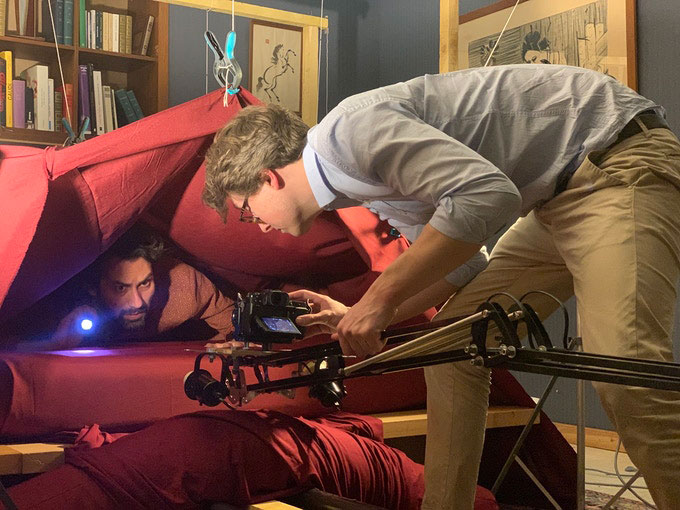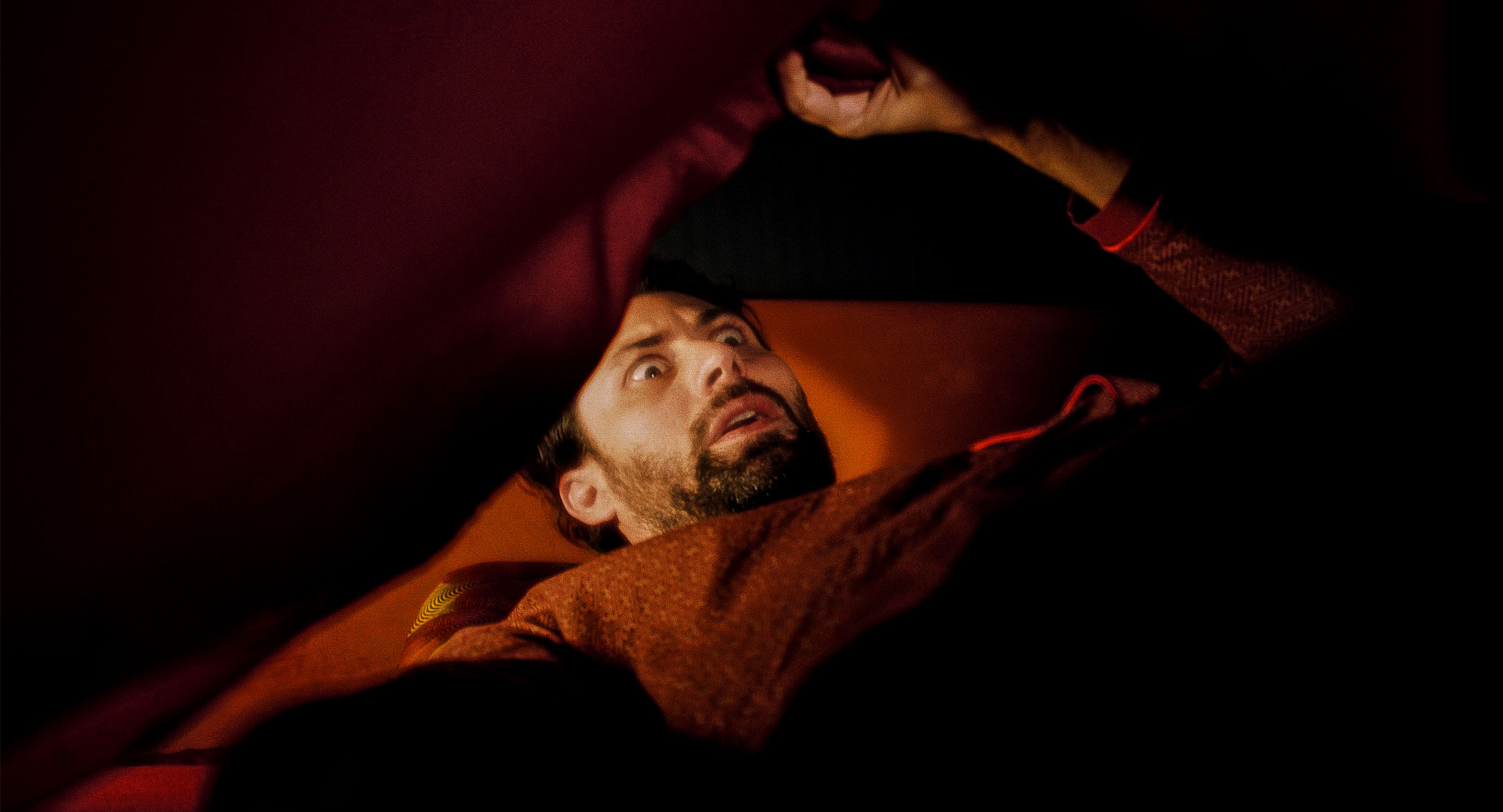
For anyone who has ever been jolted awake from a nightmare, The Eyes Below is a film for you. A dreamlike voyage into a malevolent netherworld, Alexis Bruchon’s second movie is haunting and bizarre, and makes him a filmmaker to watch.
The basic plot has investigative journalist Eugène, played by Vinicius Coelho, on the verge of breaking an explosive story. Upon retiring to bed, he becomes tormented by a supernatural entity lurking beneath the covers.
Over 77 dialogue-free minutes, Bruchon creates a threatening phantasmagoria out of the everyday. The result recalls Rodney Ascher’s The Nightmare, classic gialli, and Japanese horror, while defiantly remaining its own beast.
We caught up with writer-director Alexis Bruchon to discuss making The Eyes Below, how it links to his first film, The Woman with Leopard Shoes, and what is coming next.
THE EYES BELOW IS PLAYING AT FRIGHTFEST ON FRIDAY 26TH AUGUST
CLICK HERE FOR TICKET INFORMATION
Note: Names of Japanese filmmakers are presented the traditional way of family name first
Rob Daniel: How did the idea for The Eyes Below come about?
Alexis Bruchon: The idea came from two things. A painting called Night by the Swiss painter Ferdinand Hodler. It depicts a man lying with a sort of shadow on his belly, hidden by a sheet. I discovered it as a child, and was scared and fascinated by this image, I wanted to know what was under the sheet! As a teenager, I discovered a Japanese legend called kurobozu. It’s the exact same image as Hodler’s painting. That we have this same creature across many different cultures interested me.
Secondly, the idea came from a concept I wanted to work on: how to make a realistic thriller with a character lying in his or her bed the entire story. The problem is that these high concepts are now not very original. Several films have dealt brilliantly with this idea, and each time we have a rational explanation. In remembering Hodler’s painting I had the solution: we don’t know why this man is trapped in the bed, there is seemingly no logical explanation. But we will discover why.
It’s like Bunuel’s The Exterminating Angel, all the interest is in this space you don’t see and you don’t understand. The writing was fast, just one month, and the storyboard another month. The entire film was made in eleven months.
RD: I shan’t ask any spoiler questions, so will dance around the big revelations in the film. But did you always intend for it to be without dialogue? If so, why did you set yourself that challenge?
AB: Today, dialogue is everywhere. Look at TV series for example, most of the time it is long dialogue scenes surrounded by a little action. Don’t get me wrong, I’m a fan of dialogue! Many of my favourite films are dialogue driven, but most of the time I prefer characters who are defined by what they do and not by what they say.
I think it also depends on the film you want. When I wrote The Eyes Below, it was clear from the beginning that there will be as little dialogue as possible. No one in a dangerous situation says, “Oh my God, I’m so scared! What can I do?” We are mute, petrified. The other solution would have been to use voiceover to hear the character’s thoughts. But I didn’t like that, I wanted to tell a story using only visual elements. The more dialogue you have, the less the camera can speak.
When characters don’t have a voice, they must convey feelings through expression, body language, and reactions to the situations they are in. One of my favourite films is Blow up, and if you look carefully, there is almost no dialogue in the film. The story is a cinematic puzzle. I wanted the same, so music, editing, and colour replaces dialogue.
So, no dialogue was a choice from the beginning, and it was a challenge through the entire process. It’s my second feature and most of all a very (very!) independent movie. But, this is the time to experiment, to do what we want, and give the audience a memorable experience.

RD: The movie’s events can be interpreted in different ways. Were you ever tempted to settle for one meaning behind the film, or did you have that ambiguity from the first draft of the script?
AB: Yes, I love ambiguity in stories. That is becoming increasingly difficult because everyone wants an explanation for every aspect of the film! Especially with the internet. In my first movie, I had many people ask me why very minor moments had no explanation. But that is the beauty of cinema: you have the space to explore dark angles. Maybe it’s because I’m also an illustrator, and in an illustration you can work with evocation and no single explanation.
The Eyes Below’s script has a clear and simple story, all is explained if you look carefully. But, it would be very boring to just film everything literally… especially for a fantasy dream film. The way we chose to shoot, edit and score brought the ambiguity. I also think that it depends on your culture. For example, American audiences who have seen the film have a very pragmatic explanation: sleep paralysis! The film is absolutely not about that, but you can see where they are coming from, especially if you experience sleep paralysis! On the other hand, Europeans have very metaphoric, dreamy takes on the film, but with no explanations. In South America, it’s a story about monsters and magic.
This is the beauty of a dialogue-free movie: the film doesn’t speak but the spectators do!
RD: I loved how The Eyes Below is a film of textures and moods. What sensations do you want your audience to experience?
AB: I hope the audience will experience the pleasant feeling of being trapped in a nightmare! More seriously, I don’t know if the film is immersive, but the challenge was to play with a very common and boring place, a bed, and to transform it into a phantasmagorical, nightmarish, dangerous place. It’s what I enjoyed most during the shooting and the editing. I hope audiences will feel the same thing.
That’s why the textures, especially the colours, are important in the film. There is a 1964 Japanese anthology movie called Kwaidan, directed by Kobayashi Masaki. In that film, the colours are especially important to the feel of the different stories. In The Eyes Below, the importance of colour is the same. I can’t go into too much detail without spoiling the story, but you can’t understand the film without its use of colour. It starts in strong orange tones and moves to a very dark blue. I tried to watch the film in black and white, just for fun; it’s impossible to understand it in monochromatic images.
RD: I must confess I haven’t seen your first film, The Woman in Leopard Shoes. Is The Eyes Below linked in any plot, thematic, or directorial ways?
AB: Yes, it’s directly linked, but you don’t need to see that movie to understand this one. The Woman with Leopard Shoes is part of a thematic trilogy about the thriller, but it’s also the story of an object. I can’t say more without revealing spoilers, sorry!
From the beginning of making The Eyes Below, it was clear we would have links with the first film. I even planned to have the robber from The Woman with Leopard Shoes appear in a scene, but that didn’t happen. The two films are linked, but not in a crucial way to understanding The Eyes Below. But, I hope spotting the links will be fun for audiences who have seen both!

Were there any cinematic or literary inspirations behind the film?
Yes of course! No direct inspirations like The Woman with Leopard Shoes, which was heavily shaped by film noir. In The Eyes Below, influences come from different things. Painting, and more precisely American abstract painting. Robert Motherwell influenced our black ink creature, and the blue and orange colour designs drew from the paintings of Barnett Newman. Mark Rothko was another inspiration.
However, the main inspirations came from movies of course! Along with Kwaidan were two other Japanese films, Onibaba and Kuroneko. Both are very important to me. They were directed by Shindo Kaneto, and even though there are no direct links with our film, the way he constructed his films was an inspiration. His movies are often light on dialogue, and made one called The Naked Island which is totally dialogue free.
The giallo is also a big influence. I love Lucio Fulci’s The Psychic and, of course, Dario Argento’s Suspiria and Inferno. Sergio Martino’s movies, especially Torso, are always in my mind for the villains and the monsters! Roger Corman is, for me, the master in the art of making films from nothing. His Poe series is an absolute wonder. The Masque of the Red Death was a huge inspiration for its treatment of colour, remember those different rooms with a specific colour for each one?
The Exorcist is an all-time favourite. How William Friedkin transformed a child’s bedroom into an inferno is totally mad! More recently, I think All Is Lost, starring Robert Redford, is a masterpiece. Again, no dialogue!
Anything you can tell us about the third instalment of the trilogy?
Yes, with pleasure! The trilogy is linked by the idea of the thriller. The Woman with Leopard Shoes was a film noir. The Eyes Below is a thriller by way of horror and the fantastique. The third movie, entitled Cutting Point, will be a paranoid thriller. It will tell the story of an editor who discovers something in the film she’s editing.
I also have another project, my dream project, and thankfully it should be cheap to make. It is about two women who are kidnapped and reappear after just one day. During their detention, they saw, heard, and touched nothing. They just sat in armchairs. But, hidden things will come to light, and paranoia will take over.
I don’t know yet which project will go first, but they are both in good shape! I hope to start by the end of the year.
Finally, how do you feel about The Eyes Below playing at FrightFest 2022?
It’s an absolute joy! The Woman with Leopard Shoes was part of the Glasgow FrightFest during Covid, so like the other festivals we played at, it was all streaming. That was a frustrating time because we couldn’t be with audiences and see their reactions. Thankfully, we are now past that.
FrightFest is one of the biggest and more prestigious genre festivals in the world, so it’s huge for us. I must say this festival is particularly important for me because the programmers don’t hesitate to choose films which are varied and always surprising. They are true film lovers, and the festival is a fantastic way to discover new things. Plus, it’s in the heart of London. Can you dream of a better place for a festival?
Many thanks to Alexis Bruchon for this interview. Click below for more on Alexis’ artwork:
Official site
Instagram
Rob Daniel
Twitter: rob_a_Daniel
Podcast: The Movie Robcast
